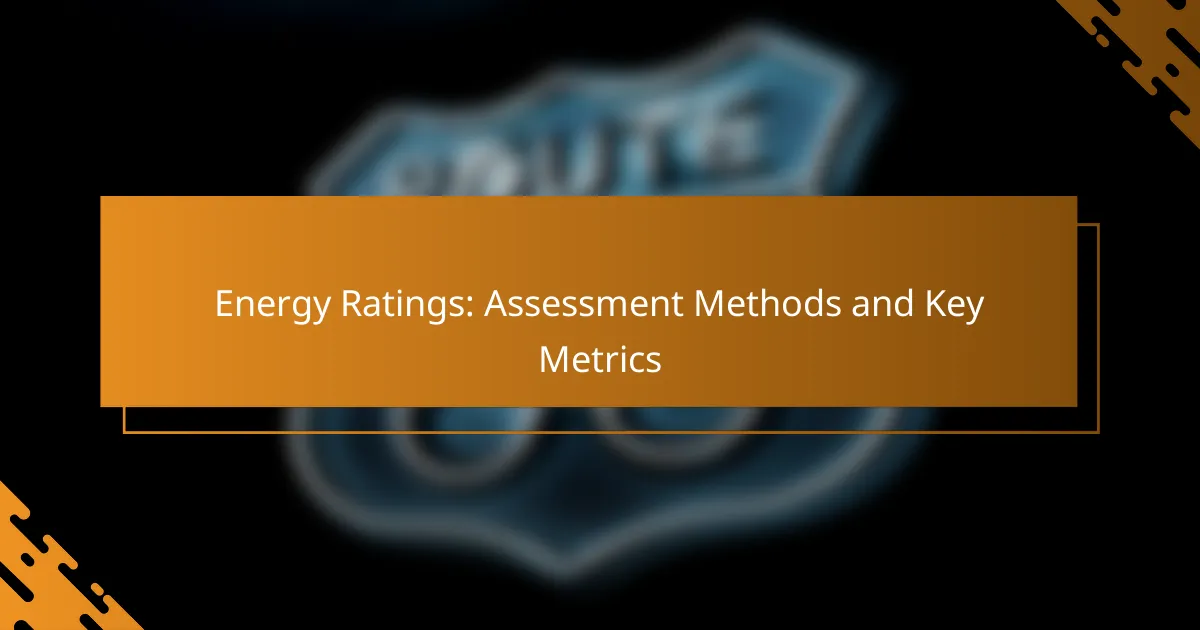Energy ratings are essential tools for assessing the energy efficiency of buildings and appliances, utilizing standardized methods to evaluate performance. By employing key metrics, these ratings provide valuable insights into energy consumption and efficiency, enabling homeowners and builders to identify improvement opportunities. Ultimately, energy ratings guide consumers in making informed purchasing decisions, often leading to significant savings through reduced energy consumption.

How are energy ratings assessed in the United States?
Energy ratings in the United States are assessed through various standardized methods that evaluate a building’s energy efficiency. These assessments help homeowners and builders understand energy consumption and identify opportunities for improvement.
Home Energy Rating System (HERS)
The Home Energy Rating System (HERS) is a widely recognized method for assessing a home’s energy performance. A certified HERS rater conducts an evaluation, scoring the home on a scale where lower scores indicate better energy efficiency.
Key factors considered in a HERS assessment include insulation levels, HVAC systems, and appliance efficiency. For example, a typical new home might score around 60, while a highly efficient home could score in the 30s or lower.
Energy Star Certification
Energy Star Certification is awarded to homes and buildings that meet strict energy efficiency guidelines set by the U.S. Environmental Protection Agency (EPA). To achieve this certification, a building must perform better than at least 75% of similar structures.
Buildings seeking Energy Star Certification undergo a comprehensive energy assessment, including inspections and testing. This certification not only signifies energy efficiency but can also lead to significant savings on utility bills over time.
LEED Certification
LEED (Leadership in Energy and Environmental Design) Certification is a globally recognized rating system for sustainable building practices. It evaluates various aspects of a building’s design, construction, and operation, focusing on energy efficiency, water usage, and materials.
LEED certification is tiered into levels: Certified, Silver, Gold, and Platinum, based on the number of points earned in different categories. For instance, a building may earn points for using renewable energy sources or for implementing water-saving technologies, making it a valuable option for environmentally conscious builders and owners.

What key metrics are used in energy ratings?
Energy ratings utilize several key metrics to assess the efficiency of buildings and appliances. These metrics provide insights into energy consumption, efficiency, and overall performance, helping consumers make informed decisions.
Energy Use Intensity (EUI)
Energy Use Intensity (EUI) measures the energy consumed by a building relative to its size, typically expressed in kilowatt-hours per square meter per year (kWh/m²/year). This metric allows for easy comparison between buildings of different sizes and types, highlighting energy efficiency performance.
When evaluating EUI, consider factors such as building occupancy, usage patterns, and local climate. A lower EUI indicates better energy efficiency, while higher values may suggest areas for improvement. For example, a commercial building might aim for an EUI of around 200-300 kWh/m²/year, depending on its function.
Seasonal Energy Efficiency Ratio (SEER)
The Seasonal Energy Efficiency Ratio (SEER) gauges the efficiency of air conditioning systems over an entire cooling season. It is calculated by dividing the total cooling output (in BTUs) by the total energy consumed (in watt-hours) during that period. A higher SEER rating indicates a more efficient system.
For residential air conditioners, SEER ratings typically range from 13 to 21, with newer models often exceeding 16. When choosing an air conditioner, consider the SEER rating alongside local climate conditions to ensure optimal performance and energy savings.
Annual Fuel Utilization Efficiency (AFUE)
Annual Fuel Utilization Efficiency (AFUE) measures the efficiency of combustion heating appliances, such as furnaces and boilers. Expressed as a percentage, AFUE indicates how much of the fuel consumed is converted into usable heat. A higher AFUE signifies better efficiency and lower energy costs.
For example, a furnace with an AFUE of 90% converts 90% of its fuel into heat, while 10% is lost. Modern furnaces typically have AFUE ratings ranging from 80% to over 95%. When selecting a heating system, prioritize higher AFUE ratings to maximize energy savings and comfort.

How do energy ratings impact purchasing decisions?
Energy ratings significantly influence purchasing decisions by providing consumers with clear insights into the efficiency and operational costs of products. Higher energy ratings often correlate with lower energy consumption, which can lead to substantial savings over time.
Informed consumer choices
Energy ratings empower consumers to make informed choices by comparing the efficiency of similar products. For instance, when shopping for appliances, a product with an A+++ rating is generally more efficient than one rated C. This clarity helps buyers prioritize energy-efficient options that align with their values and budget.
Additionally, many countries have established labeling systems that standardize energy ratings, making it easier for consumers to understand and compare products. Familiarity with these labels can enhance decision-making and reduce the likelihood of buyer’s remorse.
Long-term cost savings
Investing in energy-efficient products often leads to long-term cost savings on utility bills. For example, a high-efficiency refrigerator may cost more upfront but can save hundreds of dollars over its lifespan due to lower electricity usage. Consumers should consider the total cost of ownership rather than just the initial purchase price.
To maximize savings, consumers can look for products with energy ratings that exceed the minimum standards set by local regulations. This proactive approach can yield significant savings, particularly in regions with high energy costs.
Environmental benefits
Choosing products with high energy ratings contributes to environmental sustainability by reducing overall energy consumption and greenhouse gas emissions. For instance, energy-efficient appliances typically use less electricity, which can decrease reliance on fossil fuels and lower carbon footprints.
Moreover, many governments offer incentives for purchasing energy-efficient products, such as tax credits or rebates. These programs not only encourage consumers to make greener choices but also help mitigate the environmental impact of energy consumption on a larger scale.

What are the prerequisites for energy rating assessments?
Energy rating assessments require specific prerequisites to ensure accurate evaluations. These include compliance with building codes and the use of appropriate energy modeling software.
Building code compliance
Building code compliance is essential for energy rating assessments as it ensures that structures meet established safety and efficiency standards. This typically involves adherence to local regulations that dictate insulation, HVAC systems, and overall energy efficiency.
For example, in the United States, the International Energy Conservation Code (IECC) sets benchmarks for energy performance. Buildings must demonstrate compliance with these codes to qualify for energy ratings, which can influence financing and insurance options.
Energy modeling software requirements
Energy modeling software is crucial for accurately simulating a building’s energy performance. Assessors must use software that complies with industry standards, such as ASHRAE or RESNET, to ensure reliability in their evaluations.
Commonly used software includes EnergyPlus, eQuest, and REM/Rate, each offering different features and capabilities. It’s important to select a tool that aligns with the specific requirements of the energy rating program being pursued, as this can affect the accuracy of the assessment and the resulting energy rating. Additionally, assessors should ensure that their software is updated regularly to reflect the latest energy standards and practices.

What are the differences between energy rating systems?
Energy rating systems vary in their methodologies, criteria, and intended outcomes. Understanding these differences is crucial for selecting the appropriate system for evaluating energy efficiency in buildings and appliances.
HERS vs. Energy Star
The Home Energy Rating System (HERS) and Energy Star are both energy efficiency programs, but they serve different purposes. HERS provides a score based on a home’s energy performance, while Energy Star labels products and homes that meet specific energy efficiency criteria.
HERS ratings are typically used for new homes and renovations, with scores ranging from 0 to 150, where lower scores indicate better efficiency. In contrast, Energy Star certification requires products to meet strict energy performance standards set by the U.S. Environmental Protection Agency (EPA).
When choosing between HERS and Energy Star, consider your goals. For new construction, HERS may provide a more detailed assessment, while Energy Star is ideal for promoting energy-efficient appliances and homes.
LEED vs. BREEAM
LEED (Leadership in Energy and Environmental Design) and BREEAM (Building Research Establishment Environmental Assessment Method) are two leading green building certification systems. Both assess the sustainability of buildings but differ in their frameworks and regional focus.
LEED, developed in the U.S., uses a point-based system to evaluate various aspects of building design, construction, and operation, including energy efficiency, water usage, and materials. BREEAM, originating in the UK, emphasizes environmental performance and sustainability, with a similar point-based approach but tailored to European regulations and practices.
When selecting between LEED and BREEAM, consider your location and project goals. LEED may be more recognized in North America, while BREEAM is often preferred in Europe. Both systems can enhance a building’s marketability and reduce operational costs through improved energy efficiency.

How do energy ratings vary by region in the U.S.?
Energy ratings in the U.S. differ significantly by region due to varying climate conditions, regulations, and energy sources. Each state implements its own standards and codes, which can affect the energy efficiency of buildings and appliances.
California Title 24 Standards
California’s Title 24 Standards are among the most stringent energy efficiency regulations in the country. They require new residential and commercial buildings to meet specific energy performance metrics, including insulation, HVAC efficiency, and lighting requirements.
Under Title 24, homes must achieve a minimum energy performance score, which is calculated based on factors like energy consumption and renewable energy generation. For example, new homes often need to include solar panels to comply with these standards, significantly impacting construction costs.
New York Energy Code
The New York Energy Code sets forth energy efficiency requirements for both residential and commercial buildings, focusing on reducing energy consumption and greenhouse gas emissions. This code aligns with the state’s broader goals of sustainability and climate action.
Key components of the New York Energy Code include mandatory energy audits, insulation requirements, and efficiency standards for heating and cooling systems. Buildings are often required to meet specific energy performance metrics, which can influence design and renovation choices significantly.



